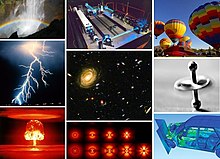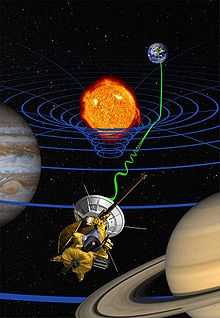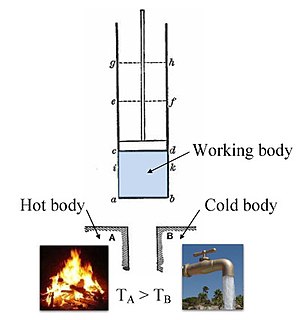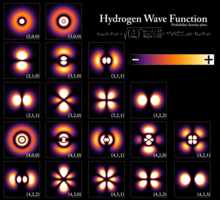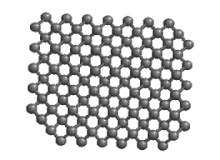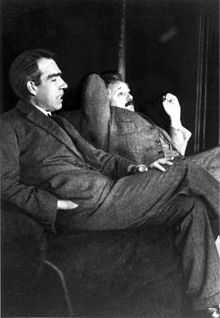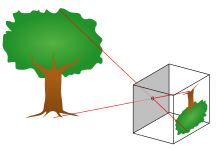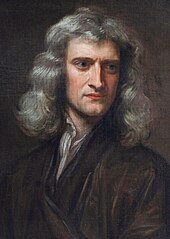Physical
The physics (from the Latin physica, and this from the ancient Greek φυσικός physikós «natural, relative to nature») is the natural science that studies the nature of the most fundamental components and phenomena of the Universe such as energy, matter, force, movement, space-time, physical magnitudes, physical properties and fundamental interactions.
The scope of physics is extraordinarily broad and can include studies as diverse as quantum mechanics, theoretical physics, or optics. Modern physics is geared toward increasing specialization, with researchers tending to focus on particular areas rather than to be universalists, like Albert Einstein or Lev Landau, who worked in a multiplicity of areas.[citation needed]
Physics is perhaps the oldest of all academic disciplines, with astronomy being one of its sub-disciplines. It also began more than two thousand years ago with the early works of Greek philosophers. In the last two millennia, physics was considered part of what we now call philosophy, chemistry, and certain branches of mathematics and biology, but during the scientific revolution in the 19th century XVII became a modern science, unique in its own right. However, in some spheres such as mathematical physics and quantum chemistry, the boundaries of physics with other branches of science remain difficult to distinguish. The formulation of theories about the laws that govern the Universe has been a central objective of physics since remote times, with the philosophy of the systematic use of quantitative experiments of observation and test as a source of verification. The key to the historical development of physics includes milestones such as Newton's law of universal gravitation and classical mechanics, Faraday's understanding of the nature of electricity and its relationship with magnetism, the theory of special relativity and the theory of Einstein's general relativity, the development of thermodynamics with James Prescott Joule and Sadi Carnot, and the model of quantum mechanics at the levels of atomic and subatomic physics with Louis-Victor de Broglie, Heisenberg, and Erwin Schrödinger.
This discipline encourages skills, methods and a scientific culture that allow us to understand our physical and living world, and then act on it. Their cognitive processes have become protagonists of general scientific and technological knowledge and doing, helping to know, theorize, experiment and evaluate acts within various systems, clarifying cause and effect in numerous phenomena. In this way, physics contributes to the conservation and preservation of resources, facilitating awareness and the effective and sustained participation of society in solving its own problems.[citation required]
Physics is significant and influential, not only because advances in understanding have often translated into new technologies, but also because new ideas in physics resonate with the other sciences, mathematics, and philosophy.[citation required]
Physics is not just a theoretical science; it is also an experimental science. Like all science, it seeks that its conclusions can be verifiable through experiments and that the theory can make predictions of future experiments based on previous observations. Given the breadth of the field of study of physics, as well as its historical development in relation to other sciences, it can be considered the fundamental or central science, since it includes chemistry, biology and electronics within its field of study., in addition to explaining their phenomena.
Physics, in its attempt to describe natural phenomena with accuracy and veracity, has reached unthinkable limits: current knowledge ranges from the description of microscopic fundamental particles to the birth of stars in the universe and even being able to know with a high probability what happened in the first moments of the birth of our universe, to name a few fields.
Advances in physics often enable breakthroughs in new technologies. For example, advances in the understanding of electromagnetism, solid state physics, and nuclear physics led directly to the development of new products that have dramatically transformed today's society, such as television, computers, household appliances, and nuclear weapons; advances in thermodynamics led to the development of industrialization; and advances in mechanics inspired the development of calculus.
Basic theories
Although physics deals with a wide variety of topics, many physicists use certain theories. Each of these theories has been tested experimentally on numerous occasions and has turned out to be an adequate approximation to nature. For example, the theory of classical mechanics accurately describes the motion of objects, as long as they are much larger than atoms and move much less than the speed of light. These theories remain areas of active research today. Chaos theory, a notable aspect of classical mechanics, was discovered in the 20th century, three centuries after it was formulated. original of classical mechanics by Newton (1642-1727).
These core theories are important tools for research into more specialized topics, and any physicist, regardless of specialization, is expected to be familiar with them. Among them are classical mechanics, quantum mechanics, thermodynamics and statistical physics, electromagnetism, and special relativity.
In classical physics
Classical physics includes the traditional branches and themes recognized and well developed before the turn of the XX century: classical mechanics, acoustics, optics, thermodynamics and electromagnetism. Classical mechanics deals with bodies on which forces act and bodies in motion and can be divided into statics (study of forces on a body or bodies not subjected to acceleration), kinematics (study of motion without taking into account its causes), and dynamics (study of movement and the forces that affect it); Mechanics can also be divided into mechanics of solids and mechanics of fluids (jointly known as continuum mechanics), the latter including branches such as hydrostatics, hydrodynamics, aerodynamics, and pneumatics. Acoustics is the study of how sound is produced, controlled, transmitted, and received. Important modern branches of acoustics include ultrasonics, the study of very high-frequency sound waves beyond the range of human hearing; bioacoustics, the physics of animal calls and hearing, and electroacoustics, the manipulation of audible sound waves through electronics.
Optics, the study of light, is concerned not only with visible light but also with infrared radiation and ultraviolet radiation, which exhibit all the phenomena of visible light except visibility, for example, reflection, refraction, interference, diffraction, scattering, and polarization of light. Heat is a form of energy, the internal energy possessed by the particles that make up a substance; thermodynamics deals with the relationships between heat and other forms of energy. Electricity and Magnetism have been studied as a single branch of physics since the intimate connection between them was discovered in the early 19th century; an electric current gives rise to a magnetic field, and a changing magnetic field induces an electric current. Electrostatics deals with electric charges at rest, electrodynamics with charges in motion, and magnetostatics with magnetic poles at rest.
In modern physics
Classical physics is generally concerned with matter and energy on the normal scale of observation, whereas much of modern physics is concerned with the behavior of matter and energy under extreme conditions or on a very large or very large scale. little. For example, atomics and nuclear physics study matter at the smallest scale in which chemical elements can be identified. Elementary particle physics is on an even smaller scale, dealing with the most basic units of matter; This branch of physics is also known as high-energy physics because of the extremely high energies required to produce many types of particles in particle accelerators. At this scale, the ordinary and common notions of space, time, matter and energy are no longer valid.
The two main theories of modern physics present a different picture of the concepts of space, time and matter from that presented by classical physics. Classical mechanics approximates nature as continuous, while quantum theory is concerned with the discrete nature of many phenomena at the atomic and subatomic level and with the complementary aspects of particles and waves in describing such phenomena. The theory of relativity deals with the description of phenomena that take place in a reference frame that is in motion with respect to an observer; the special theory of relativity deals with motion in the absence of gravitational fields and the general theory of relativity with motion and its connection with gravitation. Both quantum theory and the theory of relativity find applications in all areas of modern physics.
Difference between classical and modern physics
Although physics claims to discover universal laws, its theories lie in explicit domains of applicability.
In general terms, the laws of classical physics accurately describe systems whose major length scales are larger than the atomic scale and whose motions are much slower than the speed of light. Outside this realm, the observations do not match the predictions of classical mechanics. Einstein provided the framework of special relativity, which replaced the notions of absolute time and space with those of spacetime and allowed a precise description of systems whose components have speeds close to that of light. Planck, Schrödinger, and others introduced quantum mechanics, a probabilistic notion of particles and interactions that allowed a precise description of the atomic and subatomic scales. Later, quantum field theory unified quantum mechanics and special relativity. General relativity allowed a dynamic and curved spacetime, with which highly massive systems and the large-scale structure of the universe can be well described. General relativity has not yet been unified with the other fundamental descriptions; Several candidate theories of quantum gravity are being developed.
Branches
Classical mechanics

Classical mechanics is the branch of physics that studies the laws of behavior of macroscopic physical bodies (unlike quantum mechanics) at rest and at small speeds compared to the speed of light. In classical mechanics in general there are three invariant aspects: time is absolute, nature spontaneously realizes the minimum action and conception of a given universe.
The first development of classical mechanics is usually called Newtonian mechanics. It consists of the physical concepts based on the founding works of Sir Isaac Newton, and the mathematical methods invented by Gottfried Wilhelm Leibniz, Joseph-Louis Lagrange, Leonhard Euler, and other contemporaries, in the seventeenth century to describe the movement of the physical bodies under the influence of a system of forces. Later, more abstract methods were developed that led to the reformulations of classical mechanics known as lagrangiana and hamiltonian mechanics. These advances, made predominantly in the 18th and 19th centuries, go substantially beyond the previous works, especially because of their use of analytical mechanics. They are also used, with some modifications, in all areas of modern physics.
Classical mechanics provide extremely accurate results when studying large objects that are not extremely massive and speeds that do not approach the speed of light. When the objects examined are the size of the diameter of an atom, it is necessary to introduce the other great subfield of mechanics: quantum mechanics. To describe the speeds that are not small compared to the speed of light, special relativity is needed. In cases where objects become extremely massive, general relativity is applied. However, some modern sources include relativistic mechanics in classical physics, which in his opinion represents classic mechanics in its most developed and precise form.
There are several different formulations, in classical mechanics, to describe the same natural phenomenon that, regardless of the formal and methodological aspects they use, reach the same conclusion.
The vector mechanics, which comes directly from Newton's laws, so it is also known as "Newtonian mechanic", comes from the three equations formulated by Newton and through the differential and integral calculation, to a very exact approach to the physical phenomena. It is applicable to bodies that move in relation to an observer at small speeds compared to that of light. It was built at first for a single particle moving in a gravitational field. It is based on the treatment of two vector quantities under a causal relationship: the force and the action of the force, measured by the variation of the momentum (movement quantity). The analysis and synthesis of forces and moments constitutes the basic method of vector mechanics. It requires the privileged use of inertial reference systems.
Analytical mechanics (analytic in the mathematical sense of the word, not in the philosophical sense) is an abstract mathematical formulation on mechanics; it allows to get rid of those privileged reference systems and to have more general concepts when describing a movement with the use of the calculation of variations. Their methods are powerful and transcend from mechanics to other fields of physics. You can find the germ of the analytical mechanics in Leibniz's work, who proposes that to solve problems in mechanics, scales (less dark, according to Leibniz that the strength and time of Newton), as kinetic energy and work, are sufficient and less obscure than the vector quantities, such as force and the moment, proposed by Newton. There are two equivalent formulations: the Lagrangiana mechanical call is a reformulation of the mechanics made by Joseph Louis Lagrange which is based on the now-called Euler-Lagrange equation (second order differential sequences) and the principle of minimal action; the other, called hamiltonian mechanics, is a more theoretical reformulation based on a functional so-called hamiltonian made by William Hamilton. Hamiltonian and lagrangian mechanics are examples of analytical mechanics, where the magnitudes relate to each other by partial differential equations, which are equivalent to Newton's equations, for example Hamilton's canonical equations.Electromagnetism
Electromagnetism is the branch of physics that studies and unifies electrical and magnetic phenomena in a single theory. Electromagnetism describes the interaction of charged particles with electric and magnetic fields. Electromagnetic interaction is one of the four fundamental forces of the known universe. The charged particles interact electromagneticly through photon exchange.
Electromagnetism encompasses various phenomena of the real world, such as light. Light is an oscillating electromagnetic field that radiates from accelerated charged particles. Apart from gravity, most forces in everyday experience are the consequence of electromagnetism.
The principles of electromagnetism find applications in various related disciplines, such as microwaves, antennas, electrical machines, satellite communications, bioelectromagneticism, plasmas, nuclear research, optical fiber, interference and electromagnetic compatibility, conversion of electromechanical energy, radar meteorology, and remote observation. Electromagnetic devices include transformers, relays, radio/TV, telephones, electric motors, transmission lines, wave guides and lasers.
The foundations of electromagnetic theory were presented by Michael Faraday and formulated for the first time entirely by James Clerk Maxwell in 1865. The formulation consists of four different vectorial equations that relate the electric field, the magnetic field and their respective material sources (electric current, electrical polarization and magnetic polarization), known as Maxwell equations, which has been considered the "second great unification of physics", being the first one made by Isaac Newton.
Electromagnetic theory can be divided into electrostatic—the study of interactions between resting loads—and electrodynamics—the study of interactions between moving loads and radiation. The classical theory of electromagnetism is based on Lorentz's strength and Maxwell's equations.
Electromagnetism is a field theory; that is, the explanations and predictions it provides are based on vectorial or tensoral physical quantities dependent on position in space and time. Electromagnetism describes the macroscopic physical phenomena in which electrical loads are involved at rest and in motion, using electric and magnetic fields and their effects on solid, liquid and gaseous substances. Because it is a macroscopic theory, that is, applicable to a very large number of particles and large distances regarding the dimensions of these, electromagnetism does not describe atomic and molecular phenomena. Quantum electrodynamic provides the quantum description of this interaction, which can be unified with weak nuclear interaction according to the electrodebil model.
Relativity
The theory of relativity includes both the theory of special relativity and the theory of general relativity, formulated mainly by Albert Einstein in the early twentieth century, which sought to resolve the incompatibility between Newtonian mechanics and electromagnetism.
The theory of special relativity, published in 1905, deals with the physics of the movement of the bodies in the absence of gravitational forces, in which the Maxwell equations of electromagnetism were compatible with a reformulation of the laws of the movement. In the theory of special relativity, Einstein, Lorentz and Minkowski, among others, unified the concepts of space and time, in a tetradimensional branch that was called space-time. The special relativity was a revolutionary theory for its time, with which Newton's absolute time was relegated and concepts such as invariability in the speed of light, dilation of time, contraction of the length and equivalence between mass and energy were introduced. In addition, with the formulations of special relativity, the laws of Physics are invariant in all inertial reference systems; as a mathematical consequence, it is found as a higher speed limit to that of light and the deterministic causality that had physics until then is eliminated. It should be indicated that the laws of the Newton movement are a particular case of this theory where the mass, when traveling at very small speeds, does not experience any variation in length or is transformed into energy and at the same time can be considered absolute.
The theory of general relativity, published in 1915, is a theory of gravity that replaces Newtonian gravity, although it numerically coincides with it for weak gravitational fields and "small" speeds. General theory is reduced to special theory in the presence of gravitational fields. General relativity studies gravitational interaction as a deformation in space-time geometry. In this theory the concepts of the curvature of space-time are introduced as the cause of gravitational interaction, the principle of equivalence that says that for all local inertial observers the laws of special relativity are invariant and the introduction of the motion of a particle by geodetic lines. General relativity is not the only theory that describes gravitational attraction, but it is the one that has found the most relevant evidence. Previously, gravitational interaction was described mathematically by mass distribution, but in this theory not only does the mass perceive this interaction, but also energy, through the curvature of space-time, and therefore another mathematical language is needed to be described, the tensorial calculation. Many phenomena, such as the curvature of light by action of gravity and deviation in the orbit of Mercury, are perfectly predicted by this formulation. The general relativity also opened another field of research in physics, known as cosmology and is widely used in astrophysics.
On March 7, 2010, the Israeli Academy of Sciences publicly exhibited Einstein's original manuscripts (written in 1905). The document, which contains 46 pages of handwritten texts and mathematical formulas, was donated by Einstein to the Hebrew University of Jerusalem in 1925 on the occasion of its inauguration.Thermodynamics
Thermodynamics is the branch of physics that describes thermodynamic balance states at the macroscopic level. The Spanish language dictionary of the Royal Spanish Academy, for its part, defines thermodynamics as the branch of physics responsible for the study of the interaction between heat and other manifestations of energy. It is a phenomenological theory, based on deductive reasoning, that studies real systems, without modeling and follows an experimental method. Balance states are studied and defined by means of Extensive quantities such as internal energy, entropy, volume or molar composition of the system, or by means of non-extensive quantities derived from the above such as temperature, pressure and chemical potential; other quantities, such as immanation, electromotric force and those associated with the mechanics of continuous means in general can also be treated through thermodynamics.
Thermodynamics treats heat transfer processes, which is one of the forms of energy and how a job can be done with it. In this area it is described how matter in any of its phases (solid, liquid, gaseous) is being transformed. From a macroscopic point of view of matter, it is studied how it reacts to changes in volume, pressure and temperature, among other magnitudes. Thermodynamics are based on four fundamental principles: thermodynamic balance (or principle zero), the principle of energy conservation (first principle), the temporary increase of entropy (second principle) and the impossibility of absolute zero (third principle).
A consequence of thermodynamics is what is now known as statistical physics. This branch studies, like thermodynamics, heat transfer processes, but, contrary to the previous one, from a molecular point of view. Matter, as it is known, is composed of molecules, and knowing the behavior of one of its molecules leads us to wrong measures. That is why it should be treated as a set of elements chaotic or randomized and statistical language and mechanical considerations are used to describe macroscopic behaviors of this microscopic molecular set.
Thermodynamics offers a formal apparatus applicable only to states of equilibrium, defined as that state to "the one that every system tends to evolve and characterized because in the same all properties of the system are determined by intrinsic factors and not by external influences previously applied". Such terminal states of equilibrium are, by definition, independent of the time, and the whole formal apparatus of thermodynamic use—all thermodynamic properties Balance states are necessarily consistent with the system contours and the restrictions to which it is subjected. Through the changes produced in these restrictions (i.e. by removing limitations such as preventing the expansion of the volume of the system, preventing the flow of heat, etc.), the system will tend to evolve from one state of balance to another; comparing both states of balance, thermodynamics allows to study the processes of mass exchange and thermal energy between different thermal systems.
As a phenomenological science, thermodynamics do not deal with offering a physical interpretation of their magnitudes. The first, internal energy, is accepted as a macroscopic manifestation of microscopic energy conservation laws, which allows to characterize the energy state of the macroscopic system (macrostate). The starting point for most thermodynamic considerations are those that postulate that energy can be exchanged between systems in the form of heat or work, and that can only be done in a certain way. It also introduces a magnitude called entropy, which is defined as that extensive function of internal energy, volume and molar composition that takes maximum values in balance: the principle of maximization of entropy defines the sense in which the system evolves from one state of balance to another. It is statistical physics, intimately related to thermodynamics, which offers a physical interpretation of both magnitudes: the internal energy is identified with the sum of the individual energies of the atoms and molecules of the system, and the entropy measures the degree of order and the dynamic state of the systems, and has a very strong connection with the theory of information. Thermodynamics study and classify interactions between different systems, which leads to defining concepts such as thermodynamic system and its contour. A thermodynamic system is characterized by its properties, related to each other through state equations. These can be combined to express internal energy and thermodynamic potentials, useful to determine the balance conditions between systems and spontaneous processes.
With these tools, thermodynamics describes how systems react to changes in their environment. This can be applied to a wide variety of branches of science and engineering, such as engines, phase changes, chemical reactions, transport phenomena and even black holes.Quantum Mechanics
Quantum mechanics is the branch of physics that studies nature on small spatial scales, atomic, subatomic systems, their interactions with electromagnetic radiation and other forces, in terms of observable quantities. It is based on the observation that all forms of energy are released into discrete units or packages called how many. These few have the characteristic of all belonging to a specific group of bosons, each being linked to a fundamental interaction. (E.g., the photon belongs to the electromagnetic). Surprisingly, quantum theory only normally allows probabilistic or statistical calculations of the observed characteristics of elementary particles, understood in terms of wave functions. Schrödinger's equation plays, in quantum mechanics, the role that Newton's laws and energy conservation play in classical mechanics. That is, the prediction of the future behavior of a dynamic system and is a wave equation in terms of a wave function which predicts analytically the precise probability of events or results.
In previous theories of classical physics, energy was treated only as a continuous phenomenon, while matter is supposed to occupy a very specific region of space and is moving continuously. According to quantum theory, energy is emitted and absorbed in discrete and tiny quantities. An individual energy package, called all, in some situations behaves like a matter particle. On the other hand, it was found that particles expose some ondulatory properties when they are moving and are no longer seen as located in a particular region, but rather extended to some extent. Light or other radiation emitted or absorbed by an atom has only certain frequencies (or wavelengths), as can be seen in the spectrum line associated with the chemical element represented by such atom. Quantum theory demonstrates that such frequencies correspond to defined levels of light, or photons, and is the result of the fact that the electrons of the atom can only have certain allowed energy values. When an electron passes from one level allowed to another, an amount of energy is emitted or absorbed, whose frequency is directly proportional to the difference of energy between the two levels.
Quantum mechanics emerge timidly at the beginning of the centuryXX. within the deepest traditions of physics to give a solution to problems for which the known theories so far had exhausted their ability to explain, such as the so-called ultraviolet catastrophe in black body radiation predicted by classical statistical physics and the instability of atoms in Rutherford's atomic model. The first proposal of a very quantum principle is due to Max Planck in 1900, to solve the problem of black body radiation, which was harshly questioned, until Albert Einstein turns it into the principle that can successfully explain the photoelectric effect. The first complete mathematical formulations of quantum mechanics are not reached until the middle of the 1920s, without a coherent interpretation of theory to date, particularly of the problem of measurement.
The formalism of quantum mechanics developed during the 1920s. In 1924, Louis de Broglie proposed that, as well as light waves present particle properties, as in the photoelectric effect, particles, also have ondulatory properties. Two different formulations of quantum mechanics were presented after Broglie's suggestion. In 1926, Erwin Schrödinger's wave mechanics involved the use of a mathematical entity, the wave function, which is related to the probability of finding a particle at a given point in space. In 1925, Werner Heisenberg's matricial mechanics do not mention any of the wave functions or similar concepts, but has proven mathematically equivalent to Schrödinger's theory. An important discovery of quantum theory is the principle of uncertainty, enunciated by Heisenberg in 1927, which puts an absolute theoretical limit on the accuracy of certain measurements. As a result, the classical assumption of scientists that the physical state of a system could be measured exactly and used to predict future states had to be abandoned. This led to a philosophical revolution and led to numerous discussions among the greatest physicists of the time.
Quantum mechanics proper do not incorporate relativity into their mathematical formulation. The part of quantum mechanics that incorporates relativistic elements in a formal way to address various problems is known as relativistic quantum mechanics or already, in more correct and finished form, quantum field theory (which in turn includes quantum electrodynamics, quantum chromodynamics and electrodebil theory within the standard model) and more generally, quantum theory of fields in curved time-space. The only elementary interaction that has not been quantified so far has been gravitational interaction. This problem then constitutes one of the greatest challenges of physics of the centuryXXI. Quantum mechanics combined with the theory of relativity in the formulation of Paul Dirac of 1928, which also predicted the existence of anti-particles. Other developments of the theory include quantum statistics, presented in a form by Einstein and Bose (Bose-Einstein statistics) and in another way by Dirac and Enrico Fermi (Fermi-Dirac statistics); quantum electrodynamics, interested in the interaction between charged particles and electromagnetic fields, their generalization, quantum field theory and quantum electronics.
Quantum mechanics provide the foundation of the phenomenology of the atom, its nucleus and elemental particles (which necessarily requires the relativistic approach). Its impact on information theory, cryptography and chemistry has also been decisive among it.Fundamental physical concepts
The fundamental physical concepts are those that appear in every physical theory of matter, and therefore are concepts that appear in very different physical theories that range from classical mechanics to quantum theory of fields through the theory of relativity and non-relatisfied quantum mechanics. The fundamental character of these concepts is reflected precisely in that they are present in all physical theory that reasonably describes the matter, regardless of the assumptions and simplifications introduced.
In general a physical concept is interpretable only by virtue of the physical theory where it appears. Thus the classic description of a gas or a fluid resorts to the concept of continuous medium even though in fact the matter is formed by discrete atoms, that does not prevent the concept of continuous medium in the context of application of fluid mechanics or deformable solid mechanics from being useful. Likewise the Newtonian mechanics treats the gravitational field as a field of forces, but on the other hand the theory of general relativity considers that there are not genuinely gravitational forces but that gravitational phenomena are a manifestation of the curvature of space-time.
If a long list of physical concepts is examined quickly it is appreciated that many of them only make sense or are definable with all rigor in the context of a specific theory and therefore are not fundamental concepts that should appear in any physical description of the universe. However, a small set of physical concepts appear both in the description of classical physics, and in the description of relativistic physics and quantum mechanics. These physical concepts that seem necessary in any sufficiently wide physical theory are the so-called fundamental physical concepts, a non-exhaustive list of them could be: space, time, energy, mass, electrical load, etc.Areas of research
Theoretical Physics
Theoretical physics is the branch of physics that produces theories and models using mathematical language in order to explain and understand physical phenomena, providing the necessary tools not only for analysis but for the prediction of the behavior of physical systems. The objective of theoretical physics is to understand the universe by developing mathematical and conceptual models of reality that are used to rationalize, explain and predict the phenomena of nature, posing a physical theory of reality.
Although previous works can be considered part of this discipline, theoretical physics gains special strength from the formulation of analytical mechanics (Joseph-Louis de Lagrange, William Rowan Hamilton) and acquires a first-line relevance from the quantum and relativistic revolutions of the early twentieth century (for example the atomic bomb was a prediction of theoretical physics).
The culture of physical research in recent times has specialized so much that it has led to a separation of the physicists who are engaged in theory and others who are engaged in experiments. Theorists work in the search for mathematical models that explain the experimental results and help predict future results. Thus, theory and experiments are intimately related. Progress in physics often occurs when an experiment finds a result that cannot be explained with current theories, so we need to look for a new conceptual approach to solving the problem.
The theoretical physics has an important relationship with mathematical physics, in the latter it is emphasized to analyze the properties of the mathematical structures used in theoretical physics, and to theorize possible generalizations that can serve as more complex and general mathematical descriptions of the systems studied in theoretical physics. The theoretical physics is very related to mathematics as they supply the language used in the development of physical theories. Theorists rely on differential and integral calculation, numerical analysis and computer simulations to validate and test their physical models. Computer physics and mathematics fields are active research areas.
Theorists can conceive concepts such as parallel universes, multidimensional spaces, tiny vibrating strings or the theory of the whole and from there, perform physical hypothesis.Physics of Condensed Matter
The physics of condensed matter is the branch of physics that studies the macroscopic physical characteristics of matter, such as density, temperature, hardness or color of a material. In particular, it refers to the "condemned" phases that appear whenever the number of constituents in a system is extremely large and that the interactions between the components are strong, unlike being free without interacting. The most familiar examples of condensed phases are solids and liquids, which arise from the links and unions caused by electromagnetic interactions between atoms. Among the most exotic condensed phases are the superfluid phases and the condensed Bose-Einstein, which are in certain atomic systems under extremely low temperatures, the superconducting phase displayed by the electrons of the conduction in certain materials, and the ferromagnetic and antiferromagnetic phases of spins in atomic networks. The physics of the condensed matter seeks to make relations between the macroscopic properties, which can be measured and the behavior of their constituents at the microscopic or atomic level and thus better understand the properties of the materials.
The physics of condensed matter is the most extensive branch of contemporary physics. As an estimate, one third of all American physicists identify themselves as physicists working on issues of condensed matter. Historically, this field was born from the physics of the solid state, which is now considered one of its main subfields. The term physical condensed matter was coined, apparently, by Philip Anderson, when he renamed his research group, until then. Solid state theoryin 1967. In 1978, the Solid State Physics Division of the American Physical Society was renamed as the Condemned Matter Physics Division. The physics of condensed matter has a great overlap with areas of study of chemistry, material science, nanotechnology and engineering.
One of the reasons for condensed matter physics to receive such a name is that many of the concepts and techniques developed to study solids also apply to fluid systems. For example, conduction electrons in an electric conductor form a type of quantum liquid that has essentially the same characteristics as a fluid made up of atoms. In fact, the phenomenon of superconductivity, in which electrons are condensed into a new fluid phase in which they can flow without dissipation, presents a great analogy with the superfluid phase found in helio-3 at very low temperatures.Molecular Physics
Molecular physics is the branch of physics that studies problems related to the atomic structure of matter and its interaction with the medium, that is, matter or light.
For example, problems such as dynamics and reactions, dispersal, interactions with static and dynamic electromagnetic fields, cooling and catching atoms, atomic interferometry, interactions of ions and atoms with surfaces and solids are treated. In addition, it has multiple connections with biology, physicochemistry, material sciences, optics, atmosphere physics, plasma physics and astrophysics, among others. It plays a fundamental role in solving unresolved fundamental questions in the study of atoms and molecules.
Molecular physics includes both classic and quantum treatments, as it can treat your problems from microscopic or macroscopic points of view.Atomic Physics
Atomic physics is the branch of physics that studies the properties and behavior of atoms (electrons and atomic nuclei) as well as matter-matter and light-matter interactions on the scale of individual atoms. The study of atomic physics includes the form in which electrons are organized around the nucleus and the processes through which this order can be modified, also includes ions, as well as neutral atoms and any other particle that is considered part of the atoms. Atomic physics includes both classic and quantum treatments, as it can treat your problems from microscopic and macroscopic points of view.
Atomic physics and nuclear physics deal with different issues, the first deals with all parts of the atom, while the second does it only with the nucleus of the atom, being the latter special for its complexity. It could be said that atomic physics deals with the electromagnetic forces of the atom and makes the nucleus a punctual particle, with certain intrinsic properties of mass, load and spin.
Current research in atomic physics focuses on activities such as the cooling and capture of atoms and ions, which is interesting to remove "ruid" in measurements and avoid imprecisions when performing other experiments or measurements (e.g., in atomic clocks); increase the accuracy of the measurements of fundamental physical constants, which helps to validate other theories such as relativity or standard dynamic model; measure the effects of atomNuclear Physics
Nuclear physics is a branch of physics that studies the properties, behavior and interactions of atomic nuclei. In a broader context, nuclear physics and particles are defined as the branch of physics that studies the fundamental structure of matter and interactions between subatomic particles.
Nuclear physics is mostly known for the use of nuclear energy in nuclear power plants and the development of nuclear weapons, both nuclear fission and nuclear fusion, but this field has resulted in applications in various fields, including nuclear medicine and magnetic resonance imaging, materials implantation engineering and radiocarbon dating in geology and archaeology.Particle or high energy physics
At present, elemental particles are classified according to the so-called standard model in two large groups: bosons and feminiums. The bosons have a full spin (0, 1 or 2) and are the particles that interact with matter, while the feminiums have a semi-entero spin (1/2 or 3/2) and are the constituent particles of matter. The standard model explains how fundamental interactions in the form of particles (bones) interact with matter particles (females). Thus, electromagnetism has its particle called photon, strong nuclear interaction has gluon, weak nuclear interaction to the W and Z bosons and gravity to a hypothetical particle called graviton. Among the femiions there is more variety; there are two types: leptons and quarks. Together, the standard model contains 24 fundamental particles that constitute matter (12 particle pairs and corresponding anti-particles) together with three gauge boson families responsible for transporting the interactions.
The main study centers on particles are the Fermi or Fermilab National Laboratory, in the United States and the European Centre for Nuclear Research or CERN, on the border between Switzerland and France. In these laboratories what is achieved is to obtain energies similar to those that are believed to exist in the Big Bang and thus try to have more and more proof of the origin of the universe.Astrophysics
Astrophysics is the development and study of physics applied to astronomy. He studies stars, planets, galaxies, black holes and other astronomical objects as bodies of physics, including their composition, structure and evolution. Astrophysics uses physics to explain the properties and phenomena of star bodies through their laws, formulas and magnitudes. The beginning of the astrophysics was possibly in the centuryXIX when through the spectra the physical composition of the stars could be found. Once it was understood that the celestial bodies are composed of the same ones that make up the Earth and that the same laws of physics and chemistry apply to them, astrophysics is born as an application of physics to the phenomena observed by astronomy. Astrophysics is therefore based on the assumption that the laws of physics and chemistry are universal, that is, they are the same throughout the universe.
Because astrophysics is a very wide field, astrophysics normally apply many disciplines of physics, including nuclear physics (see Star Nucleosynthesis), relativistic physics, classical mechanics, electromagnetism, statistical physics, thermodynamics, quantum mechanics, particle physics, atom and molecular physics. In addition, astrophysics are intimately linked to cosmology, which is the area that aims to describe the origin of the universe.
This area, together with particle physics, is one of the most studied and most exciting areas in the contemporary world of physics. Since the Hubble space telescope provided us with detailed information of the most remote confines of the universe, the physicists could have a more objective view of what until that time were only theories.
At present, all or almost all astronomers have solid physical training and observations are always put in their astrophysical context, so the fields of astronomy and astrophysics are often linked. Traditionally, astronomy focuses on understanding the movements of objects, while astrophysics seeks to explain their origin, evolution and behavior. Currently, the terms "astronomy" and "astrophysics" are often used indistinctly to refer to the study of the universe.Biophysics
Biophysics is the science that studies biology with the principles and methods of physics to describe the physical phenomena of the action of living cells and organisms. It includes biomechanics, bioelectromagneticism, as well as the application of thermodynamics and other disciplines to the understanding of the functioning of biological systems. A recent attempt includes the application of quantum mechanics and their probabilistic nature of biological systems, allowing for purely physical methods for the explanation of biological properties. It is discussed whether biophysics is a branch of physics, biology or both. It can be said that the exchange of knowledge is only in the direction of biology, since it has been enriched by physical concepts and not vice versa. From a point of view it can be conceived that the knowledge and approaches accumulated in "pura" physics can be applied to the study of biological systems. In that case, biophysics gives knowledge to biology, but not to physics. However, biophysics offers physics experimental evidence that allows to corroborate theories. Examples in this sense are the physics of hearing, biomechanics, molecular motors, molecular communication, among other fields of biology addressed by physics. Biomechanics, for example, consists of the application of concepts of classic dynamics and mechanics of deformable solids to the cinematic, dynamic and structural behavior of different parts of the body.
It is estimated that during the beginning of the centuryXXI, the confluence of physicists, biologists and chemicals to the same laboratories will increase. Neuroscience studies, for example, have increased and have increasingly had greater fruits since the introduction of the laws of electromagnetism, optics and molecular physics to the study of neurons.
Other studies consider that there are branches of physics that should be developed in depth as physical problems specifically related to living matter. Thus, for example, biological polymers (such as proteins) are not large enough to treat them as a mechanical system, while they are not small enough to treat them as simple molecules in solution. Energy changes that occur during a chemical reaction catalysed by an enzyme, or phenomena such as chemical-osmotic coupling seem to require more than a deep theoretical physical approach than a biological assessment.
Among these two extremes there are problems such as the generation and propagation of the nervous impulse where biological thinking is required, plus physical thinking as well as something qualitatively new that appears with the integrating vision of the problem.
A subdisciplinary biophysics is the molecular dynamic, which tries to explain the chemical properties of biomolecules through its structure and dynamic and equilibrium properties.Summary of physical disciplines
Classification of physics with respect to theories:
- Classical mechanic
- Quantum mechanics
- Quantum Theory of Fields
- Theory of relativity
- Special relationship
- General relationship
- Statistical physics
- Thermodynamics
- Continuous media mechanics
- Mechanics of rigid solid, Mechanics of deformable solids, Elasticity, Plasticity
- Fluid mechanic.
- Electromagnetism
- Electricity
- Magnetism
- Electronics
- Astrophysics (astronomy branch)
- Geophysics (gear of geology)
- Biophysics (Biology branch)
- Optics
History
The history of physics encompasses the efforts and studies carried out by people who have tried to understand why nature and phenomena that are observed in it: the passage of the seasons, the movement of the bodies and the stars, the climatic phenomena, the properties of the materials, among others. Thanks to its vast reach and extensive history, physics is classified as a fundamental science.
Most ancient civilizations tried from the beginning to explain the functioning of their surroundings; they looked at the stars and thought how they could govern their world. This led to many interpretations of a more philosophical than physical character; not in vain at that time physics was called natural philosophy. Many philosophers find themselves in the primitive development of physics, such as Aristotle, Tales of Mileto or Democritus, as they were the first to try to seek some kind of explanation for the phenomena surrounding them. The first explanations that appeared in antiquity were based on purely philosophical considerations, without experimental verification. Some misinterpretations, such as the one made by Claudio Ptolomeo in his famous Almagesto "The Earth is in the center of the Universe and around it the stars revolve"—for thousands of years. Although the descriptive theories of the universe that left these thinkers were mistaken in their conclusions, they were valid for a long time, almost two thousand years, in part by the acceptance of the Catholic Church of several of its precepts, such as geocentric theory.
This stage, called obscurantism in the science of Europe, ends when the canon and scientist Nicolas Copernicus, who is considered the father of modern astronomy, receives in 1543 the first copy of his book, entitled From Revolutionibus Orbium Coelestium. Although Copernicus was the first to formulate plausible theories, it is another character that is considered the father of physics as we now know it. A professor of mathematics at the University of Pisa at the end of the centuryXVI I would change the history of science, using for the first time experiments to check their claims: Galileo Galilei. Through the use of the telescope to observe the firmament and its works in slanted planes, Galileo first employed the scientific method and reached conclusions capable of being verified. They were joined by other scientists such as Johannes Kepler, Blaise Pascal and Christian Huygens.
Later, in the centuryXVII, an English scientist brought together the ideas of Galileo and Kepler in one work, unifies the ideas of the celestial movement and those of the movements on Earth in what he called gravity. In 1687, Isaac Newton formulated in his work entitled Philosophiae Naturalis Principia Mathematicathe three principles of movement and a fourth law of universal gravitation, which completely transformed the physical world; all phenomena could be seen in a mechanical way.
Newton's work in this field lasts until today, as all macroscopic phenomena can be described according to its three laws. That's why for the rest of that century and later, the centuryXVIIIAll research was based on their ideas. Hence other disciplines such as thermodynamics, optics, fluid mechanics and statistical mechanics were developed. The well-known works of Daniel Bernoulli, Robert Boyle and Robert Hooke, among others, belong to this time.
In the centuryXIX There were fundamental advances in electricity and magnetism, mainly from the hand of Charles-Augustin de Coulomb, Luigi Galvani, Michael Faraday and Georg Simon Ohm, who culminated in the work of James Clerk Maxwell in 1855, which achieved the unification of both branches in the so-called electromagnetism. In addition, the first discoveries about radioactivity and the discovery of electron by Joseph John Thomson in 1897 are produced.
During the centuryXX., physics developed fully. In 1904, Hantarō Nagaoka had proposed the first model of the atom, which was partially confirmed by Ernest Rutherford in 1911, although both approaches would then be replaced by Bohr's 1913 atomic model. In 1905, Einstein formulated the theory of special relativity, which coincides with Newton's laws by saying that phenomena develop at small speeds compared to the speed of light. In 1915 he extended the theory of special relativity, formulating the theory of general relativity, which replaces the law of gravitation of Newton and understands it in the cases of small masses. Max Planck, Albert Einstein, Niels Bohr and others, developed quantum theory in order to explain anomalous experimental results on body radiation. In 1911, Ernest Rutherford deduced the existence of a positively charged atomic nucleus, from experience of particle dispersion. In 1925 Werner Heisenberg, and in 1926 Erwin Schrödinger and Paul Adrien Maurice Dirac, formulated quantum mechanics, which includes the quantum theories above and provides the theoretical tools for physics of condensed matter.
Later the quantum theory of fields was formulated, to extend quantum mechanics according to the Theory of Special Relativity, reaching its modern form in the late 1940s, thanks to the work of Richard Feynman, Julian Schwinger, Shin'ichirō Tomonaga and Freeman Dyson, who formulated the theory of quantum electrodynamics. This theory formed the basis for the development of particle physics. In 1954, Chen Ning Yang and Robert Mills developed the basis of the standard model. This model was completed in the 1970s, and with it it was possible to predict the properties of particles not previously observed, but that were discovered successively, being the last of them the quark top.
The attempts to unify the four fundamental interactions have led the physicists to new unthinkable fields. The two most accepted theories, quantum mechanics and general relativity, which are able to accurately describe the macro and the microworld, seem incompatible when you want to see them from the same point of view. That is why new theories have been formulated, such as supergravity or string theory, where research is focused at the beginning of the centuryXXI. This science does not develop only theories, it is also a discipline of experimentation. Your findings, therefore, can be checked through experiments. In addition, their theories allow to establish forecasts of evidence that will develop in the future.Ancient Astronomy
Astronomy is one of the oldest natural sciences. The first civilizations that go back to before the year 3000 a. C., like those of Sumer, that of ancient Egypt and that of the Indus Valley Civilization, had a predictive knowledge and a basic understanding of the movements of the Sun, the Moon and the stars. The stars and planets, which were believed to represent the gods, were often worshipped. Although explanations for the observed positions of the stars were often unscientific and lacking in evidence, these early observations laid the foundation for later astronomy, as stars were found to traverse great circles in the sky, which, without However, it did not explain the positions of the planets.
According to Asger Aaboe, the origins of Western astronomy lie in Mesopotamia, and all Western efforts in the exact sciences descend from late Babylonian astronomy. Egyptian astronomers left monuments showing knowledge of constellations and moons. movements of the heavenly bodies, while the Greek poet Homer wrote about various celestial objects in his Iliad and Odyssey; Later, Greek astronomers provided names, which are still used today, for most of the constellations visible from the Northern Hemisphere.
Natural Philosophy
Natural Philosophy has its origins in Greece during the Archaic period (650 BC - 480 BC), when Pre-Socratic philosophers such as Thales rejected non-naturalist explanations for natural phenomena and proclaimed that all events it had a natural cause. They proposed ideas verified by reason and observation, and many of their hypotheses were successful in experimentation; for example, atomism was found correct approximately 2,000 years after being proposed by Leucippus and his student Democritus.
Medieval and Islamic Physics
The Western Roman Empire fell in the 5th century century, causing a decline in intellectual activities in the part Western Europe. In contrast, the Eastern Roman Empire (also known as the Byzantine Empire) resisted the attacks of the barbarians, and continued to advance in various fields of knowledge, including physics.
In the VI century, Isidore of Miletus made an important compilation of the works of Archimedes that are copied in the Palimpsest of Archimedes.
In 6th century Europe , John Philopon, a Byzantine scholar, questioned Aristotle's teaching of physics and pointed out its flaws. of the. He introduced the theory of momentum. Aristotle's physics was not examined until Philopon appeared; unlike Aristotle, who based his physics on verbal argument, Philopon relied on observation. About Aristotle's physics, Philopon wrote:
But this is completely wrong, and our point of view can be corroborated by actual observation more effectively than by any kind of verbal argument. For if you drop from the same height two weights of which one is many times heavier than the other, you will see that the relationship of the times required for the movement does not depend on the relationship of the weights, but the difference of time is very small. And so, if the weight difference is not considerable, that is, if one is, say, the double that the other, there will be no difference, or an imperceptible difference, in time, although the weight difference is not at all despicable, with a body that weighs twice as much as the other.
Philoponus' critique of Aristotelian principles of physics inspired Galileo Galilei ten centuries later, during the Scientific Revolution. Galileo quoted Philopon substantially in his works in arguing that Aristotelian physics was flawed.In the year 1300 Jean Buridan, a professor at the Faculty of Arts at the University of Paris, developed the concept of momentum. It was a step towards modern ideas of inertia and momentum.
Islamic scholarship inherited Aristotelian physics from the Greeks and during the Islamic Golden Age developed it further, placing special emphasis on observation and a priori reasoning, developing the earliest forms of the method. scientific.
The most notable innovations occurred in the field of optics and vision, stemming from the works of many scientists such as Ibn Sahl, Al-Kindi, Ibn al-Haytham, Al-Farisi, and Avicenna. The most notable work was The Book of Optics (also known as Kitāb al-Manāẓir), written by Ibn al-Haytham, in which he conclusively refuted the ancient Greek idea of vision, but it also brought a new theory. In the book, he presented a study of the phenomenon of the camera obscura (his millennial version of the pinhole camera) and delved into the workings of the eye itself. Using dissections and the knowledge of previous scholars, he was able to begin to explain how light enters the eye. He claimed that the light beam is focused, but the actual explanation of how light is projected to the back of the eye had to wait until 1604. His Treatise on Light explained the camera obscura, hundreds years before the modern development of photography.
The seven-volume Book of Optics (Kitab al-Manathir) greatly influenced thinking in disciplines ranging from the theory of visual perception to the nature of perspective in medieval art, both East and West, for over 600 years. Many later European scholars and fellow polymaths, from Robert Grosseteste and Leonardo da Vinci to René Descartes, Johannes Kepler, and Isaac Newton, were in his debt. In fact, the influence of Ibn al-Haytham's Optics is on par with that of Newton's work of the same title, published 700 years later.
The translation of The Book of Optics had a great impact in Europe. From it, later European scholars were able to build devices that replicated those that Ibn al-Haytham had built, and understand how light works. From this, things as important as glasses, magnifying glasses, telescopes and cameras were developed.
Classical Physics
Physics became an independent science when early modern Europe used experimental and quantitative methods to discover what are now considered the laws of physics.
Among the main advances of this period are the replacement of the geocentric model of the Solar System by the heliocentric Copernican model, the laws governing the movement of planetary bodies determined by Kepler between 1609 and 1619, the pioneering work on telescopes and Galileo's observational astronomy in the 16th and 17th centuries, and Newton's discovery and unification of the laws of motion and Newton's law of universal gravitation, which would come to bear his name. Newton also developed calculus, the mathematical study of change, which provided new mathematical methods for solving physical problems.
The discovery of new laws in thermodynamics, chemistry, and electromagnetics was the result of increased research effort during the Industrial Revolution as energy needs increased. The laws that make up classical physics are still widely used for objects on everyday scales that they travel at non-relativistic speeds, since they provide a very close approximation in such situations, and theories such as quantum mechanics and the theory of relativity simplify to their classical equivalents at such scales. However, the inaccuracies of classical mechanics for very small objects and very high velocities led to the development of modern physics in the 20th century.
Modern Physics
Classical physics is generally concerned with matter and energy on the normal scale of observation, whereas much of modern physics is concerned with the behavior of matter and energy under extreme conditions or on a very large or very large scale. little. For example, atomics and nuclear physics study matter at the smallest scale in which chemical elements can be identified. Elementary particle physics is on an even smaller scale, dealing with the most basic units of matter; This branch of physics is also known as high-energy physics because of the extremely high energies required to produce many types of particles in particle accelerators. At this scale, the ordinary and common notions of space, time, matter and energy are no longer valid.
The two main theories of modern physics present a different picture of the concepts of space, time and matter from that presented by classical physics. Classical mechanics approximates nature as continuous, while quantum theory is concerned with the discrete nature of many phenomena at the atomic and subatomic level and with the complementary aspects of particles and waves in describing such phenomena. The theory of relativity deals with the description of phenomena that take place in a reference frame that is in motion with respect to an observer; the special theory of relativity deals with motion in the absence of gravitational fields and the general theory of relativity with motion and its connection with gravitation. Both quantum theory and the theory of relativity find applications in all areas of modern physics.
Philosophy
The philosophy of physics refers to the set of philosophical reflections on the interpretation, epistemology and guiding principles of physical theories and the nature of reality. Although the standard exposure of physical theories rarely discusses philosophical aspects, the truth is that the philosophical conceptions of scientists have played a leading role in the development of such theories. This was notorious from Newton and Kant, becoming very important in the centuryXX.when the theory of relativity led to a thorough analysis of issues traditionally studied philosophy, such as the nature of time and space. The philosophy of physics contributes through the critique of the products of physics, feeding it back.
In many respects, physics comes from Greek philosophy. From Tales' first attempt to characterize matter, to the deduction of Democritus that matter should be reduced to an invariable state, the ptolemaic astronomy of a crystalline firmment, and the book of Aristotle. Physics (an early book of physics, which tried to analyze and define the movement from a philosophical point of view), several Greek philosophers advanced their own theories of nature. Physics became known as natural philosophy until the end of the centuryXVIII.
For the centuryXIXphysics was performed as a discipline other than philosophy and other sciences. Physics, like the rest of science, rely on the philosophy of science and its "scientific method" to advance the knowledge of the physical world. The scientific method uses reasoning a priori as well as the reasoning a posteriori and the use of the Bayesian Inference to measure the validity of a given theory.
The development of physics has answered many questions from the first philosophers, but has also raised new questions. The study of the philosophical issues surrounding physics, the philosophy of physics, involves issues such as the nature of space and time, determinism and metaphysical perspectives such as empirism, naturalism and realism.
Many physicists have written about the philosophical implications of their work, for example Laplace, who defended causal determinism, and Schrödinger, who wrote about quantum mechanics. Mathematical physicist Roger Penrose had been called a Plainist by Stephen Hawking, an opinion that Penrose discusses in his book, The way to reality. Hawking referred to himself as a “disadvantaged reductionist” and disagreed with Penrose’s views.Main physical quantities
The units indicated for each magnitude are those used in the International System of Units. The units in bold are basic, the rest are derived.
- Geometrics
- Length: whose unit is metro (m)
- Area: whose unit is the square meter (m2)
- Volume: whose unit is the cubic meter (m3)
- Relating to time and proportions regarding time:
- Time: whose unity is Second (s)
- Speed: whose unit is the subway per second (m/s)
- Acceleration: whose unit is the meter per second square (m/s)2)
- Frequency: whose unit is the hertz or hertz.
- Related to dynamics:
- Force: whose unity is newton (N)
- Work: whose unity is July or jouleJ)
- Energy: whose unit is July or jouleJ)
- Power: whose unit is watt or watt (W)
- Thermodynamics and related to the quantity of matter:
- Mass: whose unity is kilogram (kg)
- Quantity of substance: whose unit is the mol
- Temperature: whose unit is kelvin (K)
- Pressure: whose unit is the pascal (Pa)
Contenido relacionado
International System Prefixes
Neutrino
Event horizon
